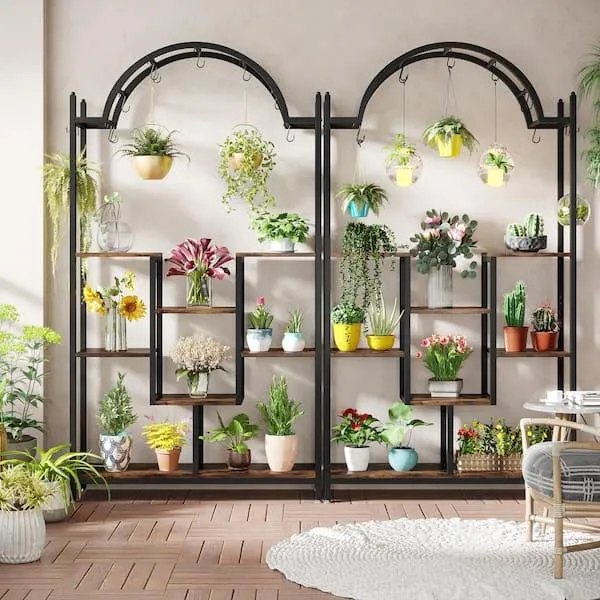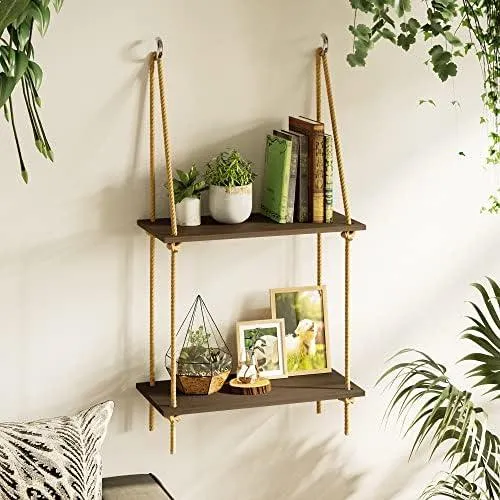All You Need to Know About Hanging Shelf Plants Indoors
Plant shelves are a fun and creative way to display your indoor plants. Whether you have limited space or simply want to decorate your walls, hanging shelf plants can add greenery and beauty to any room. In this article, I’ll cover all the basics of choosing, caring for, and styling hanging shelf plant collections indoors.
Picking the Right Plants
Consider care requirements: Most hanging plants suitable for shelves are low-light tolerant since they’ll be higher up. Look for options like pothos, philodendron, spider plants, English ivy that thrive with less direct sunlight. Avoid very high-light plants which may struggle overhead.
Factor in size: Make sure to pick plants with mature sizes that will fit neatly on your shelves. Traditionally, trailing vines likeEnglish ivy or pothos work well since they spill over beautifully. Smaller foliage plants in compact pots also display nicely.
Choose texture variety: Mix up leaf shapes, colors, and textures for visual interest. Try combining something lacy like a spider plant with broad, heart-shaped philodendron leaves. Throw in a succulent or air plant for different plant forms.
Caring for Shelf Plants
Water properly: From my experience, overwatering is a common issue with hanging plants. Check soil regularly and only water when mostly dry. Opt for pots with drainage holes to prevent soggy roots. Consider self-watering pots too.
Fertilize occasionally: During the growing season, every few weeks give your shelf plants a diluted liquid fertilizer to boost growth. I like using a all-purpose or bottle labelled for foliage plants.
Dust leaves periodically: The buildup of dust can clog plant pores overhead. Gently wipe leaves with a damp cloth every few months. Spider plants especially seem to collect dust bunnies!

Prune to shape: Trim leggy vines or remove dead growth to keep plants looking full. I sometimes snip extra long runners on my pothos so it maintains a compact shape on the shelf.
Styling Plant Shelves
Consider shelf design: Wooden, metal, or other materials all work. Narrower shelves better fit wall spaces. Make sure shelves can support soil-filled plant weights safely. Wall-mounted is ideal.
Arrange visually pleasing: Group plants together by color, texture, or size for impact. Alternate trailing plants with more upright compact varieties. I like centering bigger plants in the middle with vines cascading down sides.
Add decorative containers: Terra cotta, ceramic, or artistic glass/metal pots complement the plants. Go for a simple matching color scheme or mix up materials and hues.
Incorporate other accents: Tuck in small sculptures, photos, or dried floral arrangements. Mini string lights also glow beautifully draped overhead at night. Use items that fit the style or theme.
- Hang shelves 5-7 feet apart vertically for your eye to flow between levels naturally.
- Place plants closer together than you think for a more lush, jungle-like presentation.
- Mount shelves 6 inches out from the wall so plants have space to cascade naturally.
Proper positioning is key to achieving an artfully arranged indoor plant display. Always mount securely too for safety. With some trial and error, you’ll soon curate the perfect leafy look!
Low-Maintenance Shelf Plant Options
Here are some top choices for easy-care hanging shelf plants based on my experience growing them indoors:

Pothos: Perhaps the best trailing plant, pothos thrives with neglect. Their heart-shaped leaves come in various colors too. Nearly impossible to kill!
Spider plant: With lacy foliage and quick-multiplying spiderette plantlets, these are delightful hangers. Very forgiving of occasional dry spells.
English ivy: Evergreen ivy forms a lush cascade and tolerates low light like a champion. Can be invasive outdoors, but contained in pots.
Philodendron: Many philodendron varieties have attractive leaves and climb gracefully on shelves. Fairly resilient to under-watering.
Succulents: Cascading echeveria like ‘Perle von Nürnberg’ look enchanting in hanging baskets. Water every 2+ weeks when soil is quite dry.
Air plants: No-fuss tillandsia spp. simply need occasional spritzing and don’t require soil at all! Great for people who frequently forget to water.
Any of these forgiving options will deliver you months of low-maintenance greenery on your hanging plant shelves. Just be sure drainage is adequate so roots don’t sit in soggy soil.

Proper shelving setup combined with the right plant palette ensures your hanging collection remains flourishing with minimal effort. Feel free to experiment until you figure out the mixture tailored to your space and care preferences. Now go populate those walls with some purifying leafy beauties!
Factors to Consider When Choosing Hanging Plants for Indoor Spaces
| Plant | Light Needs | Watering Needs | Care Level | Best Locations |
|---|---|---|---|---|
| Pothos | Low | Allow soil to dry between waterings | Low maintenance | Bright indirect light, anywhere in home |
| Philodendron | Medium | Water when topsoil feels dry | Low maintenance | Bright indirect light, anywhere including bathrooms |
| Spider Plant | Low to medium | Allow soil to dry between waterings | Low maintenance | Bright indirect light, anywhere including bathrooms |
| English Ivy | Low to medium | Water when topsoil feels dry | Low maintenance | Bright indirect light, anywhere including living rooms |
| Peperomia | Medium | Water when topsoil feels dry | Low maintenance | Bright indirect light, anywhere including kitchens |
FAQ
-
What types of plants can hang from the ceiling or shelves?
There are really quite a few options for hanging plants indoors. Pothos, philodendron, spider plants, and English ivy are some of the best choices since they are very hardy and can tolerate low light. Succulents and air plants are also excellent shelf-hanging plants because they don’t require a lot of water.
-
How do I care for hanging plants?
Hanging plants need basically the same care as other indoor plants. Water them when the soil becomes dry to the touch, sometimes once every 7-10 days. Feed them with diluted water-soluble fertilizer during the growing season. Make sure to rotate the pots occasionally so all sides receive light equally. Cut off any dead or brown foliage to keep them looking their best.
-
What kind of pots or planters should I use?
For hanging plants, always choose containers that have drainage holes. Terra cotta, plastic, or woven hanging baskets all work well. The pot should be large enough for healthy root growth but not too massive. Make sure to use a hanging system, hook, or rope that can support the weight when soaked or after a strong rain. Don’t overcrowd too many pots together on one shelf.
-
How high should I hang my shelf plants?
The hanging height depends on the type of plant and amount of light in your space. A good rule of thumb is to hang pots so the tips of the leaves are 6 to 12 inches below any overhead cabinets or light fixtures. This prevents scorching from too much direct sunlight. Try different heights to find the spot where your plants thrive best before you finalize the installation.
-
What if my hanging plants get leggy?
If the stems of your hanging plants become long and lanky from not enough light, you can periodically prune them back to encourage bushier growth. Cut stem cuttings can even be propagated in water or soil to start new plants. Placing leggy plants in a spot with brighter light will help too. You may need to replace an unsalvageable plant that remains stretched out despite your efforts.

-
How do I make my shelf plants look pleasing?
Group different textured plants like foliage, flowers, and trailing vines to make visually interesting displays. Use varying pot sizes and colors. Experiment with creative pot hangers or macrame hangers that complement your decor. Refresh things up occasionally by rotating plants or switching up the arrangement. A little plant therapy goes a long way toward making your space more lovely.
